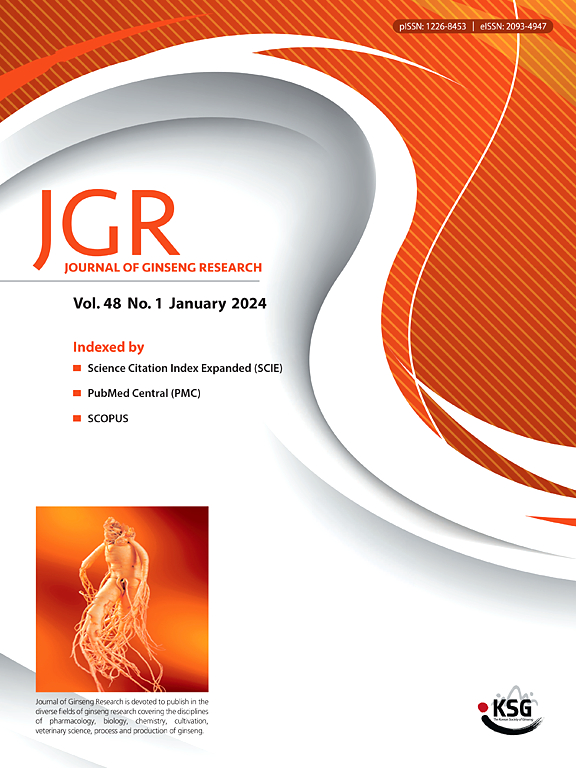Ginsenoside Rb2 demonstrates potent antiviral activity against Zika virus infection
IF 5.6
2区 医学
Q1 CHEMISTRY, MEDICINAL
引用次数: 0
Abstract
Background
Zika virus (ZIKV) infection can result in severe neurological complications, yet no approved antiviral treatments are currently available. Ginseng, a medicinal herb extensively utilized in Asian traditional medicine, has demonstrated efficacy against various diseases, which has sparked interest in exploring its potential antiviral properties for the treatment of ZIKV.
Methods
We evaluated the antiviral effects of ginsenoside Rb2 (G-Rb2) in human neuronal cell lines (SK-N-SH and CCF-STTG) and in a lethal ZIKV-infected mouse model. The antiviral efficacy was assessed using bioluminescence imaging with a NanoLuc luciferase reporter ZIKV. In vitro assays were conducted to determine the direct impact of G-Rb2 on ZIKV, while surface plasmon resonance (SPR) was employed to analyze its interaction with ZIKV envelope proteins and viral particles.
Results
G-Rb2 (200 μM) significantly inhibited ZIKV infection in vitro and protected mice from ZIKV-induced mortality. Bioluminescence imaging validated its antiviral efficacy. In vitro studies demonstrated that incubation with G-Rb2 reduced viral infectivity, and SPR analysis confirmed direct binding between G-Rb2 and ZIKV components.
Conclusion
G-Rb2 effectively inhibits ZIKV infection both in vitro and in vivo, presumably through direct interaction with viral particles. Given the accessibility of ginseng and its established processing methods, G-Rb2 emerges as a promising candidate for the treatment of ZIKV in humans. Further research is warranted to elucidate its mechanisms of action and evaluate its clinical potential.

人参皂苷Rb2对寨卡病毒感染具有有效的抗病毒活性
寨卡病毒(ZIKV)感染可导致严重的神经系统并发症,但目前尚无获批的抗病毒治疗方法。人参是亚洲传统医学中广泛使用的一种草药,已被证明对多种疾病有疗效,这引起了人们对探索其治疗寨卡病毒的潜在抗病毒特性的兴趣。方法观察人参皂苷Rb2 (G-Rb2)对人神经元细胞株SK-N-SH和CCF-STTG以及zikv致死性感染小鼠模型的抗病毒作用。采用NanoLuc荧光素酶报告基因ZIKV的生物发光成像技术评估抗病毒效果。G-Rb2对寨卡病毒的直接作用通过体外实验确定,表面等离子体共振(SPR)技术分析了G-Rb2与寨卡病毒包膜蛋白和病毒颗粒的相互作用。结果g - rb2 (200 μM)能显著抑制寨卡病毒感染,保护小鼠免于死亡。生物发光成像证实了其抗病毒效果。体外研究表明,与G-Rb2孵育可降低病毒的传染性,SPR分析证实G-Rb2与寨卡病毒组分直接结合。结论ong - rb2在体外和体内均能有效抑制寨卡病毒感染,可能与病毒颗粒直接相互作用。鉴于人参的可及性及其已建立的加工方法,G-Rb2成为治疗人类寨卡病毒的有希望的候选药物。需要进一步的研究来阐明其作用机制并评估其临床潜力。
本文章由计算机程序翻译,如有差异,请以英文原文为准。
求助全文
约1分钟内获得全文
求助全文
来源期刊

Journal of Ginseng Research
CHEMISTRY, MEDICINAL-INTEGRATIVE & COMPLEMENTARY MEDICINE
CiteScore
11.40
自引率
9.50%
发文量
111
审稿时长
6-12 weeks
期刊介绍:
Journal of Ginseng Research (JGR) is an official, open access journal of the Korean Society of Ginseng and is the only international journal publishing scholarly reports on ginseng research in the world. The journal is a bimonthly peer-reviewed publication featuring high-quality studies related to basic, pre-clinical, and clinical researches on ginseng to reflect recent progresses in ginseng research.
JGR publishes papers, either experimental or theoretical, that advance our understanding of ginseng science, including plant sciences, biology, chemistry, pharmacology, toxicology, pharmacokinetics, veterinary medicine, biochemistry, manufacture, and clinical study of ginseng since 1976. It also includes the new paradigm of integrative research, covering alternative medicinal approaches. Article types considered for publication include review articles, original research articles, and brief reports.
JGR helps researchers to understand mechanisms for traditional efficacy of ginseng and to put their clinical evidence together. It provides balanced information on basic science and clinical applications to researchers, manufacturers, practitioners, teachers, scholars, and medical doctors.
 求助内容:
求助内容: 应助结果提醒方式:
应助结果提醒方式:


